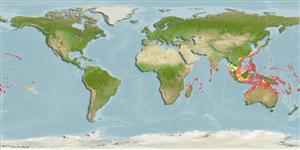Classification / Names
Common names from other countries
Main reference
Size / Weight / Age
Max length : 40.0 cm SL male/unsexed; (Ref. 48637)
Environment
Marine; reef-associated; depth range 1 - 60 m (Ref. 1602), usually 1 - 60 m (Ref. 27115)
Climate / Range
Tropical; 25°C - 28°C (Ref. 27115), preferred ?; 36°N - 34°S, 32°E - 124°W
Distribution
Indo-Pacific: East Africa, including the Mascarene Islands (Ref. 37792) to the Tuamoto Islands, north to southern Japan, south to Lord Howe and Rapa islands.
Countries | FAO areas | Ecosystems | Occurrences | Introductions
Short description
Dorsal
spines
(total): 4 - 5;
Dorsal
soft rays
(total): 23-25;
Anal
spines: 3;
Anal
soft rays: 19 - 21. Dark brown (body in life with fine pale blue-green longitudinal lines following scale rows, becoming dots anteriorly on body and on head) (Ref 9808). Small juveniles have yellowish bars and more prominent yellow specks than adults.
IUCN Red List Status (Ref. 115185)
Threat to humans
Harmless
Human uses
Aquarium: commercial
More information
ReferencesAquacultureAquaculture profileStrainsGeneticsAllele frequenciesHeritabilityDiseasesProcessingMass conversion
Tools
Special reports
Download XML
Internet sources
Estimates of some properties based on models
Phylogenetic diversity index
PD50 = 0.5078 many relatives (e.g. carps) 0.5 - 2.0 few relatives (e.g. lungfishes)
Trophic Level
2.0 ±0.00 se; Based on food items.
Resilience
Medium, minimum population doubling time 1.4 - 4.4 years (K=0.425; Tmax=33)
Vulnerability
High to very high vulnerability (66 of 100)
Price category
